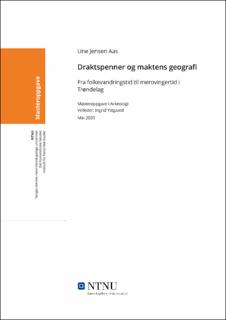| dc.contributor.advisor | Ystgaard, Ingrid | |
| dc.contributor.author | Aas, Une Jensen | |
| dc.date.accessioned | 2021-09-13T16:04:39Z | |
| dc.date.available | 2021-09-13T16:04:39Z | |
| dc.date.issued | 2020 | |
| dc.identifier | no.ntnu:inspera:58319055:3133481 | |
| dc.identifier.uri | https://hdl.handle.net/11250/2775573 | |
| dc.description.abstract | Denne oppgaven utforsker forholdene mellom de materielle og geografiske endringene som oppstår i draktspennematerialet fra folkevandringstid og merovingertid, dets tilknytning til elitens praksis, og hva disse endringene kan fortelle oss om samfunnsendringene i det politisk-geografiske området i Trøndelag. For å utforske disse forholdene er det utvalgte spennematerialet presentert kronologisk, hvor man ser hvilke spennetyper som oppstår og faller bort i løpet av periodene. En analyse av spennematerialets geografiske distribusjon blir så gjennomfør for å finne periodenes funnkonsentrasjoner. Basert på resultatene av materialpresentasjonen og den geografiske analysen, blir det videre gjennomført en analyse av materialets endringer i et forsøk på å belyse endringer i elitens praksis. Resultatene av dette blir så diskutert i lys av hypoteser om samfunnsendringene som oppstår i overgangen fra eldre til yngre jernalder.
I undersøkelsen kommer det tydelig frem at spennematerialet i overgangen fra folkevandringstid til tidlig merovingertid var sterkt påvirket av en nedgangstid i samfunnet. Spennene fra denne perioden er mindre i størrelse, opptrer i en ny form og funnmengde har også sunket. Dette taler om at endringer i praksis har oppstått, men praksisen som spenne inngår i har ikke opphørt fullstendig, men blitt nedprioritert. Funnmaterialet opptrer også på nye steder i landskapet, og i noen områder ser man starten på maktsentralisering som blir tydeligere senere i merovingertid. Disse områdene får en oppblomstring mot slutten av merovingertid, der den fullstendige funnmengde av spenner overgår funnmengde fra folkevandringstid. Ved å inkludere våpenfunn fra de samme periodene, blir det enda tydeligere hvilke områder den øverste eliten har tilhørt. Det kan også se ut til at maktsentraliseringer i områder i merovingertid, har gått på bekostning av maktsenter kjent fra folkevandringstid. Samfunnsendringene i de aktuelle periodene har trolig blitt dominert av en kombinasjon mellom kriser og maktsentraliseringer. | |
| dc.description.abstract | This thesis explores the relationships between the material and geographical changes that occur in the ornamental brooches from the Migration and Merovingian period, its association with the elite's practice, and what these changes can tell us about the societal changes in the political-geographical area of Trøndelag. To explore these conditions, the selected material is presented chronologically, which shows which types occur and cease during the periods. An analysis of the geographical distribution of the brooch material is then carried out to find the concentrations of the periods. Based on the results of the material presentation and the geographical analysis, an analysis of the material's changes is further conducted to shed light on changes in elite practice. The results of this are then discussed in light of hypotheses about the social changes that occur in the transition from early to late Iron Age.
The study shows that the brooch material in the transition from the Migration period to the early Merovingian period was strongly influenced by a downturn in society. The brooches from this period are smaller in size, has changed shape and the amount of discoveries has decreased. This indicates that changes in practice have occurred, but the practice that the brooches is part of has not ceased completely. The finds also appear in new places in the landscape and in some areas you can see the start of centralization of power, which becomes more prominent later in the Merovingian period. These areas are flourishing towards the end of the Merovingian period, where the complete number of finds exceeds the amount from the Migration period. By including weapon finds from the same periods, it becomes even clearer which areas the supreme elite belonged to. It may also appear that centralization of power in areas in the Merovingian period has been at the expense of others. Societal changes in the periods have probably been dominated by a combination of crises and power centralizations. | |
| dc.language | | |
| dc.publisher | NTNU | |
| dc.title | Draktspenner og maktens geografi | |
| dc.type | Master thesis | |
